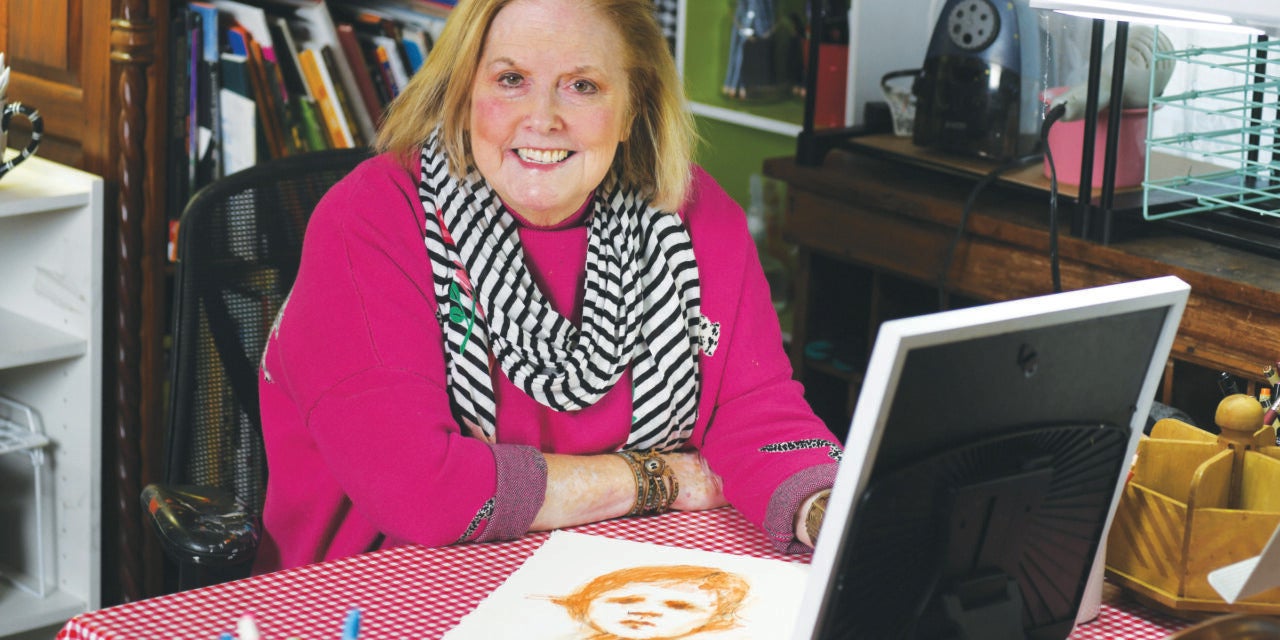By Julie Mabus
Jacki Baker Kellum is a pioneer in the very marrow of her bones.
Through her mother’s line, she is the 10th great-grandchild of Captain William Claiborne, who left England 400 years ago and headed to the Jamestown Colony in 1621 as King James’ surveyor, just 14 years after Jamestown’s founding.
Jacki is the sixth great-grandchild of Samuel Duval Jr., who was among the pioneers who trekked over the Appalachian Mountains through the Cumberland Gap, crossing Virginia and Kentucky more than 250 years ago.
Her second great-grandfather, William Thomas Dunscomb, moved the family again, ending their westward migration in Missouri.
Jacki hails from Gideon, Mo., a town of 500 people, “and getting smaller every day,” she laughed. “Gideon is a rural cotton patch close to the Mississippi River. Farmers didn’t have picking equipment when I was a kid in the 1950s, so all the local children picked cotton.
“We got 3 cents a pound. In those days, the school’s fall session started in July and stopped in September for a six-week vacation so the kids could pick cotton. Isn’t it something they called it a ‘vacation.’”
 As her story unfolded, I witnessed a transformation in her bearing from a self-effacing and giddy interviewee to a proud and focused artist. “My father had a barber shop,” she added. “That’s what he did, but it’s not who he was. He was an artist, a cartoonist.” She joined in drawing with her father when time allowed.
As her story unfolded, I witnessed a transformation in her bearing from a self-effacing and giddy interviewee to a proud and focused artist. “My father had a barber shop,” she added. “That’s what he did, but it’s not who he was. He was an artist, a cartoonist.” She joined in drawing with her father when time allowed.
When asked if she was a good artist as a child, she said: “I can’t say when I knew I was talented. It was just always there. I remember my dad saying, ‘You can’t study art in college. You aren’t precise enough.’ That’s funny now because he didn’t understand expressionism. That’s really my style.”
Albeit modest, it is imminently clear that Jacki is a force of nature, a pioneer. As we discussed her life, the barriers she faced were simply stumbling blocks she met and kicked aside. I’m not sure she is even aware of her power.
The public school system in small-town Gideon was wise enough to import teachers from other areas. “My seventh-grade English teacher, Miss King, saved my life,” Jacki said. “She was the window through which I began seeing the world. On the first day of class, she put these words on the board, ‘Hitch your wagon to a star.'” With Jacki’s pioneer spirit, those words resonated. ”She introduced me to William Blake and his themes of innocence and experience.”
Blake, the 18th-century English poet and painter, believed children possess an innate, untainted sense of innocence that is destroyed over time through the abuse of social, religious and political systems.
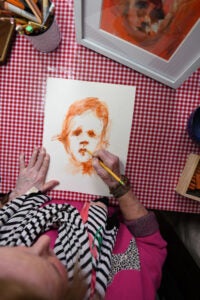 A childlike innocence runs through this artist. It is no coincidence Jacki displays her gift through expressionism. The expressionist style emerged in the early 20th century as a reaction to societal institutions and materialism. Expressionism is her romantic and emotional reaction to a hardened world. Perhaps William Blake’s belief system of innocence to experience was not a model Jacki emulated; rather, it was a system she recognized and understood.
A childlike innocence runs through this artist. It is no coincidence Jacki displays her gift through expressionism. The expressionist style emerged in the early 20th century as a reaction to societal institutions and materialism. Expressionism is her romantic and emotional reaction to a hardened world. Perhaps William Blake’s belief system of innocence to experience was not a model Jacki emulated; rather, it was a system she recognized and understood.
Jacki advanced this notion: “Children have a stronger sense of intuition than most adults have. When I am painting, I consider it a great day when something within myself takes over and essentially completes my project for me. This gentle urging is intuition.”
In a sense, Jacki’s high school days were idyllic. Like her father, she was a great storyteller and stood out among her peers. She was student body president, cheerleader and valedictorian of her class, but life shifted for Jacki when she started Ole Miss in 1968.
“I was so naive,” she said. “I’d never experienced anything like sorority rush. No one knew me; no one prepared me. I didn’t have the necessary credentials. Don’t get me wrong, I joined a great sorority. But I remember at one of the houses, I was led into a small room with girls who probably wouldn’t be asked back. Call it intuition. Here’s something funny: I only figured out my family didn’t have any money when I started at Ole Miss.”
Jacki took 25 hours every semester so she could take more art. “My major was English, but I had plenty of hours for an art major; I just didn’t declare it,” she said of satisfying both her family’s wishes as well as her own.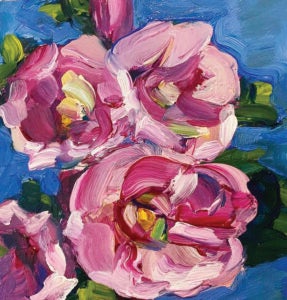
Despite her imagined inadequacies, Jacki excelled academically and socially at Ole Miss. “But I never got a grip socially, not really,” she said. “And things really changed my junior year,” when she was in a body-crushing accident that fall.
“At an Ole Miss football game in Jackson, I left the game with my date to pick up donuts for the group – always ready to please everyone around me,” she explained. “A large truck hit the train tracks and landed on me. The driver was drunk. I can tell you that accident cured me of being a people pleaser.”
Jacki eventually returned to Ole Miss in a wheelchair and crutches with facial scars. “It was traumatic, but my little Pinto, a gift from my grandmother, helped me cope,” she said. “I would drive out into the country to get away. I found this church in Bay Springs and would sit there for hours to absorb the quiet.”
Despite the obstacles, Jacki was elected president of her sorority and finished Ole Miss with top grades. “But forever after, my life was a reaction to that wreck,” she said. “I got married right out of college. We were both too young. I was so silly; I thought it was my last chance. He wanted to be a doctor, but started with dentistry. So, of course, I supported us while he went to a Tennessee dental school.”
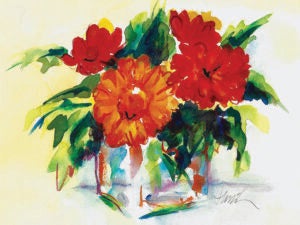 Afterward, the couple returned to Mississippi, where her then-husband practiced dentistry with his father in Tupelo and Jacki commuted to Ole Miss, working on her MFA in visual art through the direction of art professors Jere Allen and Tom Dewey.
Afterward, the couple returned to Mississippi, where her then-husband practiced dentistry with his father in Tupelo and Jacki commuted to Ole Miss, working on her MFA in visual art through the direction of art professors Jere Allen and Tom Dewey.
“Tom taught me about red chalk.” Jacki picked up a piece of chalk, and within seconds, the haunting face of a child materialized on her sketchpad.
“That resembles one of Jere Allen’s tronies,” I reacted (see “Oxford Magazine,” August 2023, Volume 7, Issue 4).
“Jere taught me about these 16th- and 17th-century faces, these tronies, and Tom taught me about the use of red chalk,” Jacki added.
Red chalk is a draftsman’s drawing material used since the 15th century, composed of iron oxide suspended in clay. Da Vinci used it in his sketches for the “Last Supper.” Michelangelo began his work on the Sistine Chapel ceiling utilizing the medium.
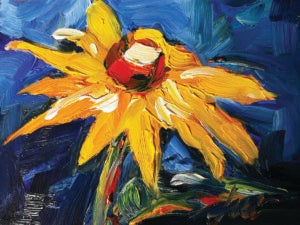 After six years in Tupelo and with two small children in tow, Jacki followed her husband to Jackson to fulfill his dream to become an anesthesiologist. That meant another four years in medical school.
After six years in Tupelo and with two small children in tow, Jacki followed her husband to Jackson to fulfill his dream to become an anesthesiologist. That meant another four years in medical school.
Undaunted, Jacki met the challenge through a job at St. Andrews Episcopal School, teaching art to the youngest students. And, with each step, Jacki broke barriers.
“The school wanted an art exhibit every year, something the kids could create for their parents,” she said. “My first attempt garnered little or no interest.” That would not do. Next year, she would do the undoable.
Jacki covered the walls of the large vestibule outside the art room with brown butcher paper. On it she painted a landscape of the Judean Hills, emulating the area around Bethlehem. Against one of the walls she built a realistic manger with natural straw and the children created the figures, stuffed with newspaper. A school-wide competition determined who made the baby Jesus and every student created stars, while Jacki crafted the guiding star in the East.
Jacki was captivated by the innocence of the children and their untouched approach to Christmas. “As a teacher, I felt I was a conductor bringing out the best gift of each child,” she said.
When her third baby was born – and her husband walked out on the family – Jacki taught art in the Madison County schools. She was chosen as Target Corporation’s National Teacher of the Year for Mississippi within a few years.
Thirteen years later, her home burned to the ground. “I had hundreds of illustrations for a picture book I was putting together, and all my work perished in the fire,” she said. “I will tell you that I have always swung from one miracle to the next. Because of that fire, I moved north and was able to live in New Jersey for several years.”
Once settled there, she began redoing the burned illustrations. And thanks to the recommendation of a new friend, Jacki took a position as librarian, reading to children for the next 18 years. Her book reviews led her to publishing her own book, “Waking Up the Sun,” which is her homage to the fearless rooster, the world’s “alarm clock,” who has had, since the dawn of history, the task of “waking up the sun.”
When asked about her favorite medium, “watercolor” is Jacki’s answer: “I’ve always said watercolor is the poetry of art. It captures in just a few strokes the essence of the work. Watercolor is the medium of quick, first impressions. But we must talk about painterly and bravura in my oils and acrylics. Watercolor is fragile…oil is different…A painter can be almost as physical as he wants in oil painting…in oil, I can be more daring.”
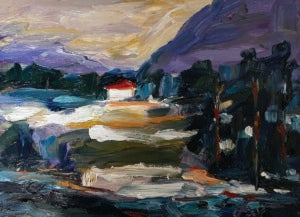 Painterliness probably entered the lexicon of artists in the late 1800s. The style was evident in the works of the great masters; it’s all about the use and appearance of raw brush strokes in acrylic or oils.
Painterliness probably entered the lexicon of artists in the late 1800s. The style was evident in the works of the great masters; it’s all about the use and appearance of raw brush strokes in acrylic or oils.
If the style is painterly, an artist paints with bravura. Jacki described it: “With bravura, an artist’s brushstrokes have an energy all their own, and a segment of a painting can be enjoyed simply because of the way that it is painted, irrespective of the subject matter of the painting.”
Jacki next moved back south about seven years ago, landing in Arkansas, where she taught writing at North Arkansas College. While there, Jacki submitted her profoundly touching children’s story, ”The Donkey’s Song,” to Doubleday, an imprint of Random House Children’s Books. It was published in October 2022.
Last year, Jacki came “home,” this time to Water Valley, where there is land to create her gardens, space to paint and draw, and time to write that new children’s story of untouched bliss.
Perhaps coming home is coming back to a time of innocence. In the words of William Blake’s “Auguries of Innocence” –
To see a World in a Grain of Sand
And a Heaven in a Wild Flower,
Hold Infinity in the palm of your hand
And eternity in an hour.

